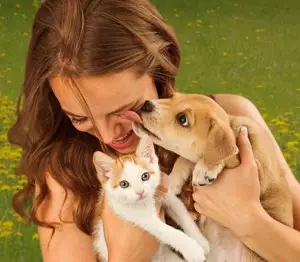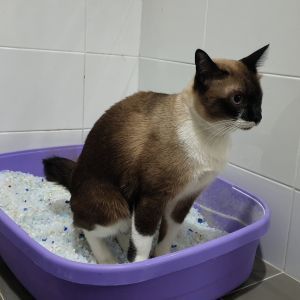How to manage inappropriate urination in cats
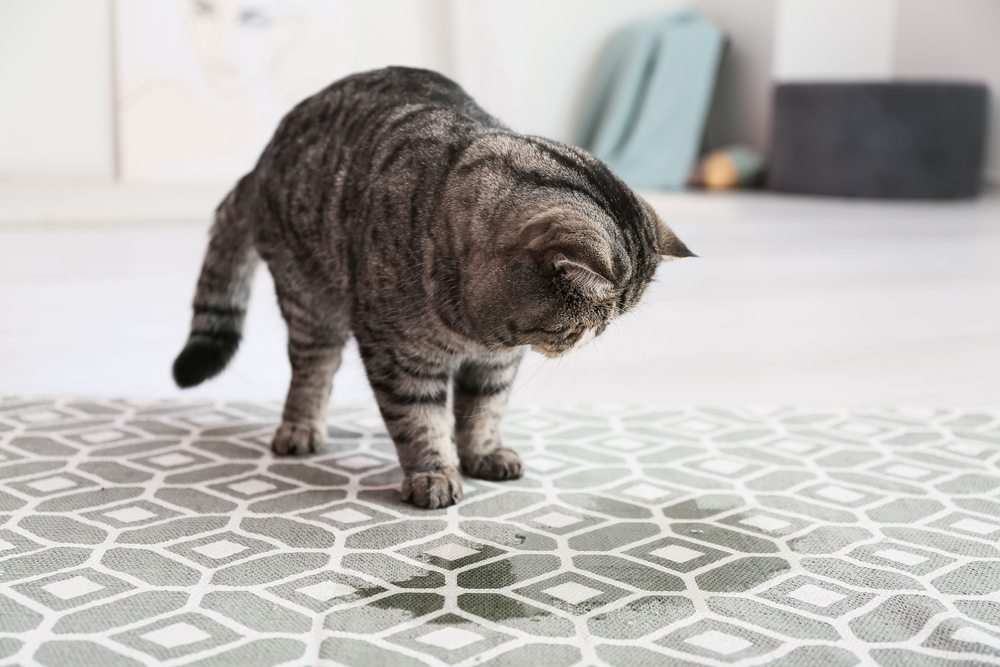
Inappropriate urination is a term that describes the common but undesirable feline behaviour of urinating outside of the litter tray. Cats urinate for two distinct purposes: to empty their bladder when it is full, and to “mark“ or define their territory, also known as spraying. Generally, cats will urinate in their litter tray, but sometimes a cat will urinate outside of the litter tray to a point where it gets out of hand and becomes problematic for the owner.
 In some cases, there is an underlying medical condition that causes changes in urinary behaviours. This is often an issue involving the urinary tract but sometimes a systemic disease is responsible. In other cases, there is a behavioural cause for a cat’s inappropriate urination. Cats are frequently stressed by various social and environmental conditions, and this can manifest as excessive urine marking or spraying in undesirable locations.
In some cases, there is an underlying medical condition that causes changes in urinary behaviours. This is often an issue involving the urinary tract but sometimes a systemic disease is responsible. In other cases, there is a behavioural cause for a cat’s inappropriate urination. Cats are frequently stressed by various social and environmental conditions, and this can manifest as excessive urine marking or spraying in undesirable locations.
It is important to consult your vet if your cat’s urinary habits suddenly change – for example, he or she house-soils or urinates more or less than usual – because any underlying disease behind these behaviours could have serious consequences. If there is no medical problem, there is usually a behavioural issue, such as an aversion to the litter box, a preference for urinating in a specific place, or a conflict with another cat or other stressful situation. Treatment will be directed at the underlying cause and may entail medical and/or behavioural interventions. These may entail anti-anxiety medication, improving the litter tray hygiene and/or minimising stressors in the home.
Continue reading below to learn more about inappropriate urination in cats or jump ahead to:
- Symptoms of inappropriate urination in cats
- Causes of inappropriate urination in cats
- Diagnosis of inappropriate urination in cats
- Treatment for inappropriate urination in cats
What is inappropriate urination?
Inappropriate urination refers to urinating outside of the litter tray in unusual places or on odd objects. This is the most common behaviour problem reports by cat owners – in fact, it’s estimated that 10% of all cats will eliminate inappropriately at some point in their lives. Although cats have a reputation for fastidious cleanliness, inappropriate urination is one of the most common complaints of cat owners. In fact, many cats are turned outside, given away, or even prematurely euthanised because of this frustrating, messy and smelly problem.
The term “inappropriate elimination” is not a specific condition or illness; rather, it’s a category of toileting issues that usually have a medical or behavioural cause. It has also been termed as “undesirable elimination behaviour” by some animal behavioural experts, who see these urinating behaviours as not “inappropriate” for the cat – only for the owner. This is because cats urinate for two distinct reasons – voiding and urine marking – both of which are “normal” cat behaviours.
In most cases, inappropriate urination results from one of the following circumstances: a difficulty in urine voiding, an uptake or increase of urine marking, or an aversion to the litter tray.
Voiding difficulties
Voiding entails emptying the bladder because it feels full. The cat voids in a squatting position. Cats that cannot void urine normally may try to urinate often, but urination is slow and painful and only a small amount of urine is expelled. When the bladder does not empty properly, it can become stretched out and begin to overflow and leak, and over time the cat may develop incontinence. Often, the cat with a voiding difficulty cannot reach the litter tray in time and consequently, inappropriate urination occurs.
Urine marking behaviour
Urine marking entails deliberate, overt urination, usually in socially significant or obvious areas. The cat marks while standing up, with the tail raised and quivering, by directing a small stream of urine backwards onto a vertical surface, such as a wall, curtain, back of chair or door. Marking on a vertical surface is termed spraying.
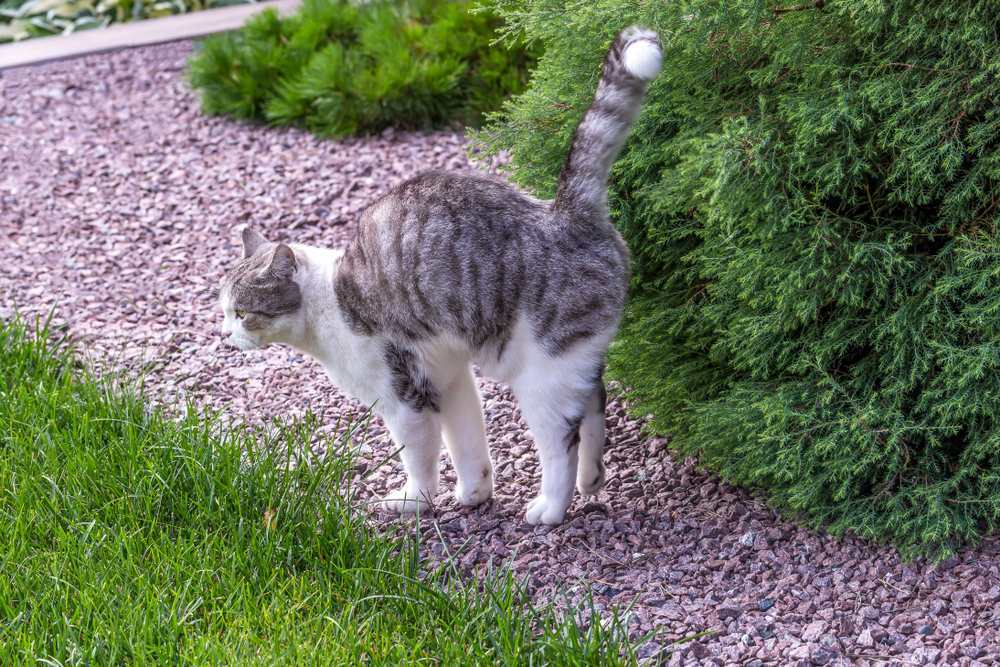
Urine marking is a form of communication used by cats. Its purpose is to leave a message for other cats; i.e., to announce his or her presence, to delineate territorial boundaries, or to advertise that he or she is ready to mate. Marking also allows a cat to surround itself with its own familiar smells and so feel more secure. Cats that feel safe in their environment, who have no conflicts and are spayed or neutered (so don’t need a mate) have little reason to mark, and probably will not do so. However, if they are anxious, insecure or want a mate, they will probably react by marking their territory.
Approximately 30% of cats that urinate inappropriately are engaging in urine marking behaviour. Urine marking is most common in unneutered male cats, and, to a lesser degree, unspayed females, but 10% of neutered males and 5% of neutered females also spray. In households with more than seven cats, it’s likely that one or more of the cats will spray.
Litter tray aversion
Cats may urinate inappropriately if they develop an aversion to some characteristic of their litter tray. There are numerous reasons why litter tray aversion may occur in a cat that has previously used the litter tray without any issues – these may be behavioural (the cat doesn’t like the type of litter used) or psychological (the cat was frightened while in the litter tray and now associates the tray with fear). Once the cat begins to avoid the litter tray, she may then develop an alternate preference for urination – on a particular surface in a certain location, for example – and the problem can become a chronic one.
To learn more about litter tray aversion and how to manage it, see here.
Symptoms of inappropriate urination in cats
It is not always straight-forward to determine if a cat is urinating outside of the litter tray because of a litter tray aversion, a voiding difficulty, or for urine marking purposes. In all of these situations, the cat may continue to urinate in the box from time to time. However, there are some distinctive symptoms that may help us distinguish between them – if we are willing to do a bit of unpleasant – and smelly – detective work.
Symptoms of urine voiding problems
- Urination often occurs outside of the litter tray
- Urination occurs in different places, often close to the litter tray
- Urine puddles outside the tray usually are large
- Urination occurs on a horizontal surface
- Urination occurs on a variety of surfaces (tile, carpet, floorboards)
- Cat may try to bury or cover the urine
- Cat usually squats discretely while urinating
- Cat has difficulty entering or leaving the litter tray
Symptoms of urine marking problems
- Urination frequently takes place in the litter tray (for emptying the bladder)
- Urine is also sprayed on to vertical surfaces such as walls
- Urine puddles outside the tray are small (spraying usually involves small volumes of urine – not emptying whole bladder)
- Cat displays distinctive behaviours while spraying (cat backs up to wall or object, tail quivers, appears trance-like, vocalises, kneads the paws, ejects rapid squirt of urine)
- Urination usually occurs in a specific place or surface each time (on the owner’s bed or clothing, on carpets or rugs, near a door or window)
- Urine has a pungent smell (because it contains extra chemicals for communicating)
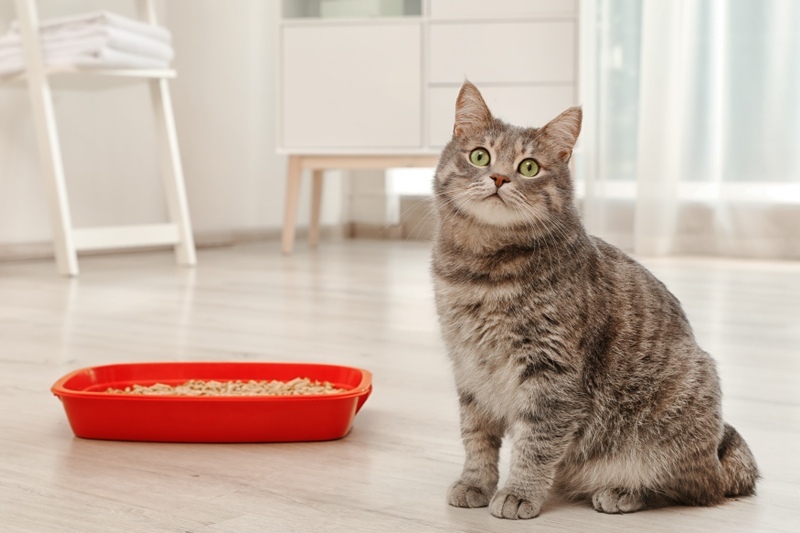
Causes of inappropriate urination in cats
Inappropriate urination could indicate a medical disorder, a territorial marking issue, a social or environmental problem, or a behavioural problem, and often the distinctions between these are not clear. Several factors may be in play and some cases involve medical symptoms resulting from psychological stress. In many cases of inappropriate urination, the cat – whether male or female – is not neutered.
Medical causes
Your cat may have a medical condition affecting her urinary tract, which can interfere with urination. There are many such conditions, including bladder stones, bacterial infections, and a group of inflammatory diseases of the bladder and urinary tract, which cause painful urination and an increased urgency to urinate. Other systemic conditions can also cause problems with urination, including metabolic diseases, nervous system disorders and cognitive decline. While many of these conditions can be painful and debilitating, it is important to be aware that affected cats do not always act sick. In fact, inappropriate urination is often the first sign of clinical disease that cat owners notice.
Common health issues which may affect urination include:
- Urinary tract infection (UTI) – the cat frequently enters the litter tray but produces only small amounts of urine. Learn more about UTI in cats.
- Feline interstitial cystitis – the cat eliminates outside the litter tray because of the urgency to urinate and associated pain of urination (a life-threatening condition that occurs mainly in young adult cats).
- Bladder stones or blockage – she frequently enters the tray, experiences pain and mews or cries when she tries to eliminate; her abdomen may be tender to the touch.
- Feline lower urinary tract disease (FLUTD) – she urinates frequently and painfully, producing small amounts, with blood in the urine. Learn more about FLUTD.
- Kidney and liver disease – these can cause the cat to drink more and urinate more frequently, leading to a failure to use the litter tray.
- Metabolic and hormonal disturbances such as diabetes and hyperthyroidism – common feline conditions that cause excessive drinking and urination.
- Age related cognitive (brain function) decline– this can lead to changes in elimination habits, including house soiling.
- Conditions affecting the nerves, muscles, or joints – these can lead to pain, discomfort, stiffness or weakness that affect the cat’s ability to get to the litter tray, climb into the litter tray, or get into a comfortable position in the tray.
- Arthritis – usually occurs in older cats, who often urinate next to the tray or near it because they cannot squat properly or cannot step into a high-sided tray. Learn more about arthritis in cats.
Behavioural causes
If a medical cause for inappropriate urination is ruled out, there is likely to be an underlying behavioural cause. There are various behavioural reasons why cats may begin to urinate inappropriately. According to a prominent veterinary manual, “some of these are related to the litter box, while others reflect social conflicts and involve anxiety or aggression.”
Incomplete toilet training
Some cats may have never had consistent toilet training or developed a solid preference or acceptance of using a litter tray. This can include cats who are accustomed to toileting outside or who were brought into the home as strays or rescues.
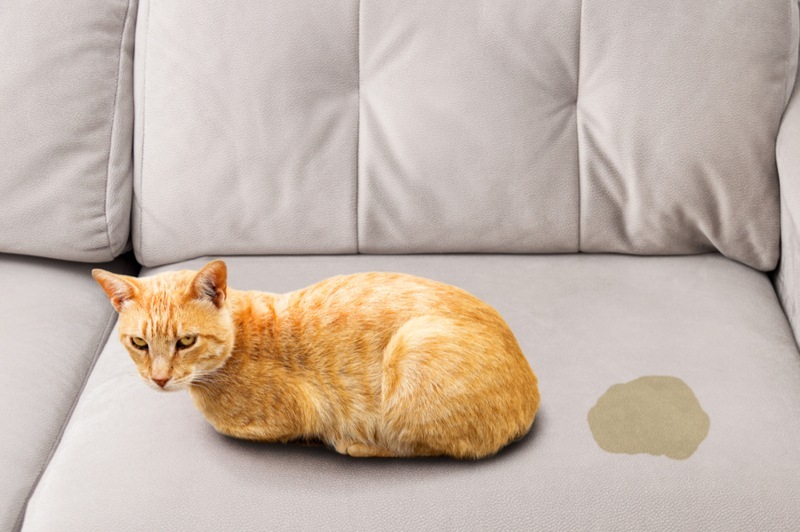
Stress and anxiety
Cats can become acutely or chronically unwell as a result of stress. Stress can affect many systems in the feline body, including the urinary tract, bowels and skin, leading to ongoing or recurrent health problems such as urinary tract infection, irritable bowel and dermatological (skin) conditions.
Additionally, stress in cats often manifests as inappropriate urination for two reasons. Firstly, stressed cats tend to have more dilute urine because stress hormones can interfere with processes in the kidneys which concentrate and conserve urine, therefore, they need to urinate more often. The second reason relates to cats’ tendency to “mark” spots in the house with urine as a means of marking their territory. While territorial urine marking may be considered as normal feline behaviour, some cats will also mark their environment in response to stress or anxiety.
As well as toileting issues, there may be other behavioural clues your cat is feeling stressed and anxious; these include hiding, avoiding things, being over or under-active, not playing, changes in appetite, excessive grooming, losing hair, fighting with other cats in the home, and mood changes such as being grumpy, irritable or aggressive.
Social stress
Social stress is a large contributor to inappropriate urination. Cats are highly territorial animals who can be reluctant to accept new individuals – feline or otherwise – into the household. Expecting cats to live together harmoniously in our houses is often unrealistic and can sometimes be highly stressful for one or more cats involved. This can lead to territorial anxiety, which then leads to inappropriate urine marking in order to reassert territorial boundaries.
Environmental stress
Cats are generally sensitive creatures who do not cope well with change or disruptions to their environment. Any changes in the home, from a new baby to rearranging the furniture, can lead to feelings of frustration, stress, or anxiety. Even sensory input such as temperature, weather conditions, sights, sounds and smells can greatly affect a cat’s mood and behaviour.
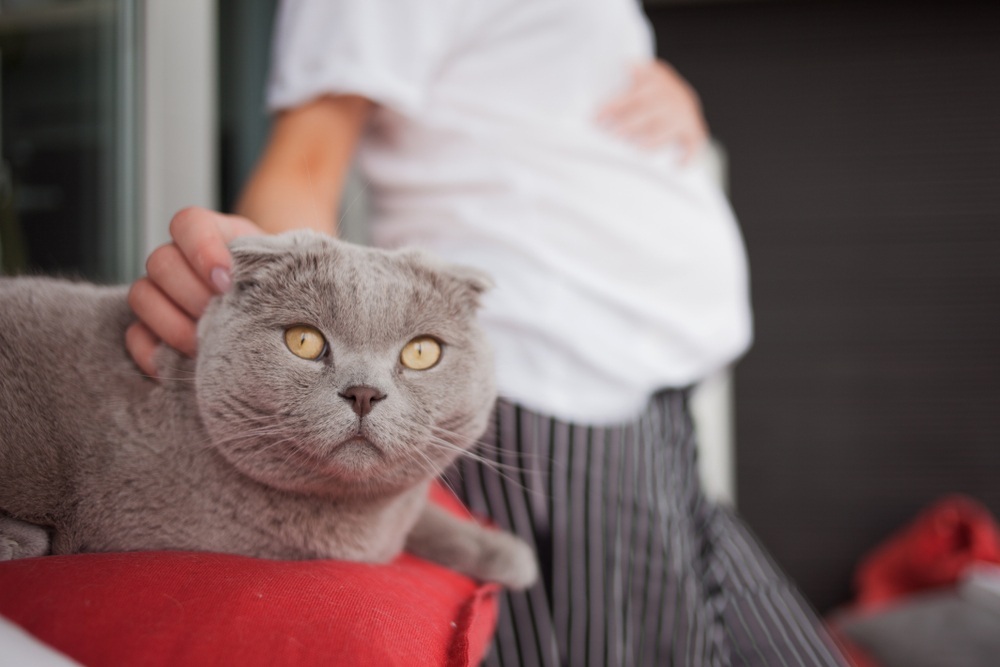
Potential stress-inducing situations in the home environment include:
- A new person, cat or other animal in the home
- Moving to a new home
- A home renovation
- New furniture
- Prolonged or sudden absence of the owner, or their return after an absence
- Death of a family pet
- Visitors, humans or other animals
- A new cat or other animal next door or nearby
- Noisy construction work nearby
- Change of bedding
- Change of diet
- Change of routine
Multiple causes
There may be a combination of medical and behavioural reasons why your cat is urinating appropriately. Additionally, one cause may lead to another. For example, a cat with a medical condition such as a urinary tract disorder that can’t make it to the litter tray in time will urinate wherever she is. She may then develop a preference for the new site and continue to urinate there. Or, she may associate the litter tray with pain and then avoid it.
How is inappropriate urination in cats diagnosed?
Consult your veterinarian as soon as possible if your cat begins to urinate inappropriately. There are several painful and debilitating medical conditions that can lead to inappropriate urination, and it is vital to either rule these out, or diagnose and treat them, as soon as possible. Be aware that cats with medical conditions do not always act sick. Urgency is important because some urinary tract-related diseases can lead to death in less than 48 hours, so waiting to see what happens could prove to be fatal.
The vet will conduct a physical examination of your cat and carry out a urinalysis test and, if necessary, additional diagnostic tests such as blood tests, radiographs or a urine culture. Some urinary problems can be transient or recurrent so repeated tests may be needed to diagnose the problem. Conditions to rule out are dependent on the age of the cat, as young adult cats tend to get different diseases from senior cats. If all medical conditions are excluded, your vet will look for behavioural causes of the problem.
 Your vet will take a detailed behavioural history of the problem by asking questions about how and where the accidents occur, litter tray details (including the number and location of trays, cleaning routines, and type of litter), and the home environment. The vet will also enquire about the onset, frequency, duration and progression of the problem. Note that if the cause is behavioural, it is still important to address it promptly – the longer the behaviour persists, the more likely it is to become a habit.
Your vet will take a detailed behavioural history of the problem by asking questions about how and where the accidents occur, litter tray details (including the number and location of trays, cleaning routines, and type of litter), and the home environment. The vet will also enquire about the onset, frequency, duration and progression of the problem. Note that if the cause is behavioural, it is still important to address it promptly – the longer the behaviour persists, the more likely it is to become a habit.
When there are multiple cats in the home, it may be difficult to determine which one is responsible for the inappropriate urination and you may need to separate or confine one or more cats in order to do so. Alternatively, a special dye can be administered to one of the cats, and the soiled areas can then be evaluated with a special light to determine if that is the cat that is responsible. Another option is to set up a camera to record the soiling behaviour if it usually occurs in the same spot. This will also help to distinguish between urine marking and other forms of house soiling.
Treatment for inappropriate urination in cats
Your veterinarian can help you to identify the best treatment program for your cat, which will depend on the underlying cause and severity of the problem. The various treatment options may be used individually or in combination; for example, if anxiety is determined as the cause, medication and behaviour modification techniques may both be used. A full resolution is possible, but this depends on early intervention, correct diagnosis of the underlying cause, and time and effort to resolve the problem. Monitoring of treatment progress is important. Be sure to note and record any changes in behaviour so it is clear whether the treatment interventions are working.
Treatment options include:
- Managing any social and/or environmental stressors in the home or neighbourhood.
- Modifying toileting behaviours by relearning basic toilet training and/or changing emotions regarding toileting.
- Prescribing medication and/or adjunctive treatments which may be helpful, such as pheromones and nutritional supplements.
Managing social and environmental stressors
Stressors within the home or neighbourhood may be the reason behind inappropriate urination in cats. Cats tend to spray inappropriately when they perceive a threat to their territory, such as a new cat entering the home or outside cats being close by. They may also spray if they are frustrated with their environmental circumstances, for example, being on a new or restrictive diet, having insufficient playtime, or in response to the smell of new furniture or carpeting. Try as best as possible to ease your cat’s frustrations. If you are introducing a new diet, do it gradually or discontinue it until the spraying is under control. If boredom may be a factor, try to increase your cat’s playtime.
It is essential to address any social stress occurring within the home. Where tension exists in multi-cat households and cats do not get on well, there can be conflict over important resources such as the toileting area – often, cats are not comfortable sharing a toilet unless they are very close friends.
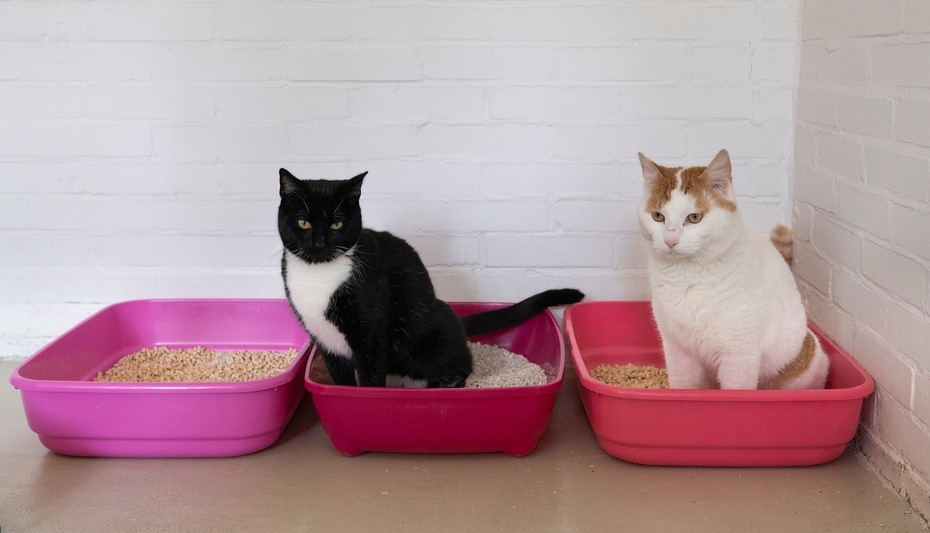
Spraying can result from territorial disputes between cats in the same household. They may need to be separated for a while and reintroduced slowly, using food treats to reward and encourage peaceful behaviour. It is vital to provide multiple litter trays throughout the house – as many as there are cats in the house, plus one extra. This decreases competition and gives each cat a tray of his or her own. If a new cat is brought into the home, provide additional trays in separate areas of the house.
Consider whether another animal or an incident has perhaps traumatised the cat while she was in the litter tray, as this may have made her afraid to use the tray. If she has had a traumatic experience such as being attacked by another cat, having something fall on her, or even lightning strikes outside, she may not be comfortable using the tray in that spot ever again. Try to position the tray so that she has more than one way out (i.e. it’s not surrounded on three sides) and where she can see anyone approaching; this will give her more confidence while she’s using it and make her less vulnerable to ambush.
Stressors from outside the home are usually more difficult to control but it’s important to try to identify any such stimuli that may be causing your cat to spray. If you have neighbourhood cats that visit, try to block your cat’s view of them through the windows by closing blinds or curtains and prevent her from jumping onto windowsills by placing double-sided tape on them. If possible, deter outside cats from approaching the house – motion detectors that trigger sprinklers are one way to do so!
If another cat has left their odour around the house or backyard, which has led to a change in your cat’s urinating habits, it is important to eliminate the other cats’ smells. Cleaning the affected area, as well as any objects or materials touched by the other cat, may help to reduce the stress your cat is feeling and prevent her from feeling the need to mark her territory. Always ensure that all cleaning products and deodorisers are safe for use around cats.
Modifying toileting behaviours
Most cats will instinctively use a litter tray from a very early age. However, if your cat has consistently urinated outside of the tray, it is possible that she has never grasped proper use of the tray, in which case you may be able to re-train her to use the it correctly. Try placing her in the litter tray within half an hour of feeding time and encourage her to scratch around in the litter.

Praise the cat when she uses the tray correctly but do not punish her or drag her to the tray if she has an accident outside of the tray – cats are unlikely to associate your punishment with their mistake! Don’t offer treats to entice her into the tray, as cats like to urinate in private, but you can place toys and treats near the tray to encourage her to use it.
A more controversial strategy is to restrict the cat’s movement by blocking off the areas where inappropriate urination has occurred and/or confining her to a small area that contains her litter tray. By limiting her movement and toileting options, she may re-train herself to the tray. However, some cats may find this to be very stressful, so proceed with caution, be sure to monitor the process carefully, and try other strategies first.
If your cat has more recently taken to urinating or spraying in an inappropriate spot, you can make a few changes to see if you can steer your cat back to the litter tray:
Neutralise the odour
Cat behaviouralists advise thoroughly cleaning the area and spraying it with odour neutralizers, as removing the urine smell may help to decrease your cat’s desire to urinate there. Cats usually continue to spray in areas they have marked with their scent, so cleaning cat-soiled items is crucial for breaking this cycle. Cleaning is most effective when it’s done soon after an item was soiled. Use an enzymatic cleaner as odours need to be neutralised, not merely deodorised, to escape a cat’s keen sense of smell. Cover the area with foil or plastic sheeting and block it off for a few weeks to give the neutralizer time to work. Avoid using ammonia-, vinegar- or bleach-based cleaning products, as these smell like urine to cats and may encourage the cat to keep toileting in the newly cleaned area!
Change the area
Another recommendation from the experts is to change the function of the soiled area by turning it into a feeding, playing, sleeping or scratching area, which may reduce the cat’s desire to urinate there. Try placing food and water, toys or bedding in the area so that the cat no longer views it as a toilet. Other suggestions to discourage her from toileting there include adding bright lights or motion sensors to the area, or placing tin foil, upside-down carpet runners, or double-sided sticky tape in the area.
Mix up the surface
Cats can develop preferences for certain surfaces to urinate on, such as a wooden floor, a tiled floor, carpeting or even a pile of laundry. Blocking access to the favoured surface or object, or making changes to it, may help to break the cycle. For example, you could keep doors closed to prevent access to the area or cover the spot with furniture or pot plants. Or you could cover it over with a different surface, such as a plastic sheet, upside-down carpet runner or mat, or sheets of newspaper, or even sandpaper or electronic mats that deliver a mild, harmless shock. You could also try putting a sample of her preferred fabric, tile or carpet in her litter tray to encourage her to recommence using the tray, then slowly transition back to litter.
Catch her in the act
A bell on her collar can let you know her whereabouts. If you can catch her within the first seconds of her toileting, you could startle her with a water gun or a loud noise, so that she associates being startled with those actions. It is important that you startle rather than scare her, as fear will only worsen the problem. Moreover, if you catch her after the act, your window of opportunity is gone—you must catch her just as she’s about to start!
Medication and/or adjunctive treatments
Where there is an underlying medical cause for inappropriate urination, the vet may prescribe medication to manage or treat the underlying condition. In such cases, treating the underlying cause may also resolve the house soiling and no further treatment may be required.
Medication may also be prescribed where anxiety is determined as the cause of inappropriate urination. In this case, medication is typically only part of the solution, used in conjunction with social and environmental changes. Be aware that medication can have potentially harmful side effects, and not all cats are good candidates. Cats placed on long-term medication must be monitored closely by a vet.
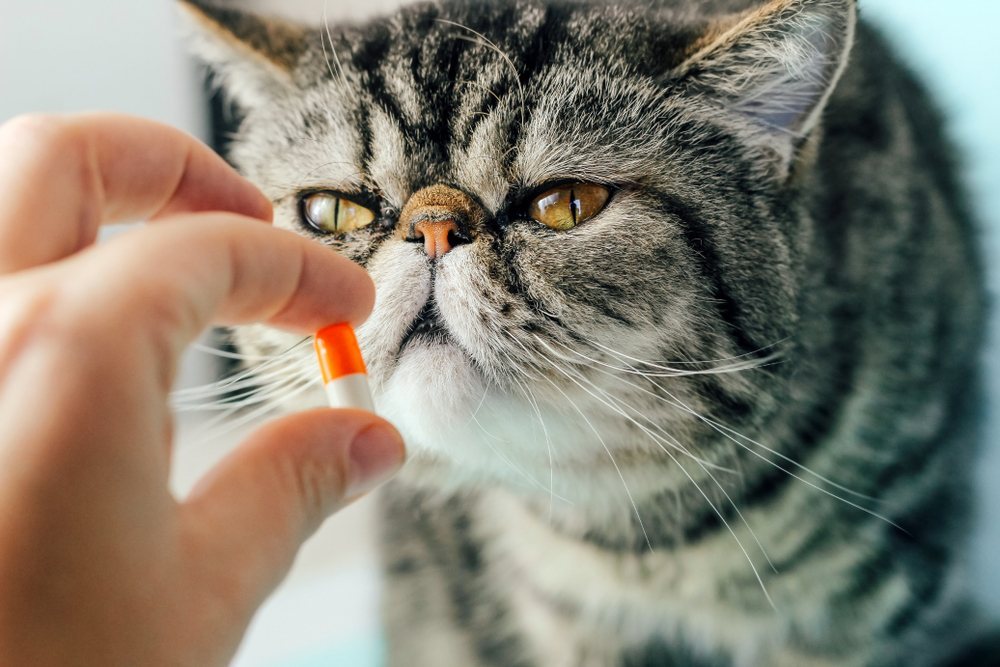
Anti-anxiety medication
Because urine marking is often a response to anxiety, anti-anxiety drugs are more likely to prescribed for inappropriate spraying behaviour. Anti-anxiety medications may be tremendously helpful if the source of stress cannot be identified or cannot be modified.
Anti-anxiety medications for inappropriate urination include:
- Clomipramine – the first choice of many behaviourists for urine-marking cats because it has shown close to 90% effectiveness, and in most cats requires only once a day dosing.
- Fluoxetine – also known as Prozac® ,this medication is as effective as clomipramine. Generally, while taking the medication cats do not mark, but if the medication is discontinued, marking may resume.
- Buspar – approximately 75% effective in reducing inappropriate urination. Approximately half the cats who use it do not resume inappropriate urination after the initial course, while the other half re-develop the problem and must continue to take it.
- Amitriptyline – a neurotransmitter blocker, many veterinarians have reported success with it, however, there are some potential heart-related side effects.
- Valium – has achieved success rates between 55% and 75% but inappropriate urination often resumes when it is discontinued. Because of a small population of cats who develop a life-threatening liver syndrome, it is no longer the treatment of choice.
- Female Hormone Treatments – used in the past to control inappropriate urination. These treatments were not as effective the newer medications listed above, and carried potentially serious side effects, including mammary cancer and diabetes mellitus.
Adjunctive treatments
Several other products that help with anxiety may be recommended by your vet, especially if your cat is not amenable to taking medication or there is a medical condition that precludes medication. Treatments such as these are compatible with the therapies listed above and may be used in combination with behaviour modification and/or with medications.
Pheromone sprays and diffusers
These are applied to the area being marked rather than administered to the cat in the form of a medication. They mimic the pheromones that cats deposit when rubbing their face or cheeks on items to scent mark them (i.e. facial marking). The pheromones send a message that the cat understands, stating that the area is safe and there is nothing to be concerned about. This has a general calming effect and many cats will not spray on areas that have this scent.
Dietary Supplements
- Alpha-casozepine is a natural protein contained in cow’s milk that has been used to treat nonspecific anxiety in cats. It is available in tablet form and is also one of the main ingredients in the CALM Diet.
- L-theanine occurs naturally in the tea plant and is available in tablet form for dogs and cats. It is thought to lessen some stress conditions and mild anxiety related problems in pets and may also have a neuroprotectant effect.
Additional strategies / suggestions
- Neutering or spaying an intact cat will reduce the potent effect of hormones on spraying behaviour.
- As a temporary measure, you could consider purchasing kitty diapers to contain the urine when the cat is unsupervised.
- Punishment is never recommended when dealing with inappropriate urination and may even make the problem worse.
Step-by-Step Action Plan
- Rule out medical issues that can cause inappropriate urination, such as urinary tract infections (UTIs), bladder stones, idiopathic cystitis, and systemic diseases like kidney disease and diabetes.
- Identify environmental factors (e.g., moving house, introducing new pets or changes in household dynamics) that can lead to inappropriate urination.
- Address any behavioral concerns
- Try practical solutions, like using pheromone diffusers, providing multiple litter boxes, improving litter box management or enriching the cat’s environment to reduce stress and territorial behaviours.
- If the above steps do not resolve the problem, then consider visiting your veterinarian or an animal behaviourist to diagnose the underlying cause and provide treatment strategies.

